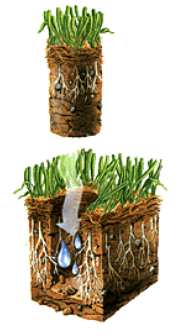Core Aeration Improves the Structure of Your Lawn...
 Aeration is the process of mechanically removing small plugs of thatch and soil from the lawn to improve soil structure and reduce compaction. Core aeration helps the lawn's health and vigor, and reduces maintenance requirements. It also reduces compaction of soil which allows grass to produce a stronger, healthier root system. Fertilizer can get down to the root system more readily. An aerated lawn will absorb more water, and it breaks up the thatch layer. Annually aerated lawns will almost never develop a damaging thatch layer. Annual aeration is beneficial for all lawns. Lawns growing on heavy clay or subsoil, and lawns exposed to intense use, benefit from two or more aerations each year. Spring and fall are ideal times to aerate. We generally recommend aerating in the fall, after the stress of summer. Aeration, in combination with fertilization, enhances root growth and improves spring green-
Aeration is the process of mechanically removing small plugs of thatch and soil from the lawn to improve soil structure and reduce compaction. Core aeration helps the lawn's health and vigor, and reduces maintenance requirements. It also reduces compaction of soil which allows grass to produce a stronger, healthier root system. Fertilizer can get down to the root system more readily. An aerated lawn will absorb more water, and it breaks up the thatch layer. Annually aerated lawns will almost never develop a damaging thatch layer. Annual aeration is beneficial for all lawns. Lawns growing on heavy clay or subsoil, and lawns exposed to intense use, benefit from two or more aerations each year. Spring and fall are ideal times to aerate. We generally recommend aerating in the fall, after the stress of summer. Aeration, in combination with fertilization, enhances root growth and improves spring green-
Plugs should be left on the lawn. As the plugs begin to break down, microbes in the plugs will begin working on the built-
The two step process guaranteed to improve your lawn.
An aeration treatment removes small cores of soil and thatch to allow air, moisture and fertilizer to penetrate down to the root zone. The cores brought to the surface contain microorganisms, which help the breakdown of the woody thatch tissue. This allows the roots of existing grass plants to spread out and grow deeper, creating a healthier, thicker lawn. Aerating your lawn is a great way to reduce thatch, loosen up compacted soils, and make it easier for water and nutrients to reach the roots of your turf.